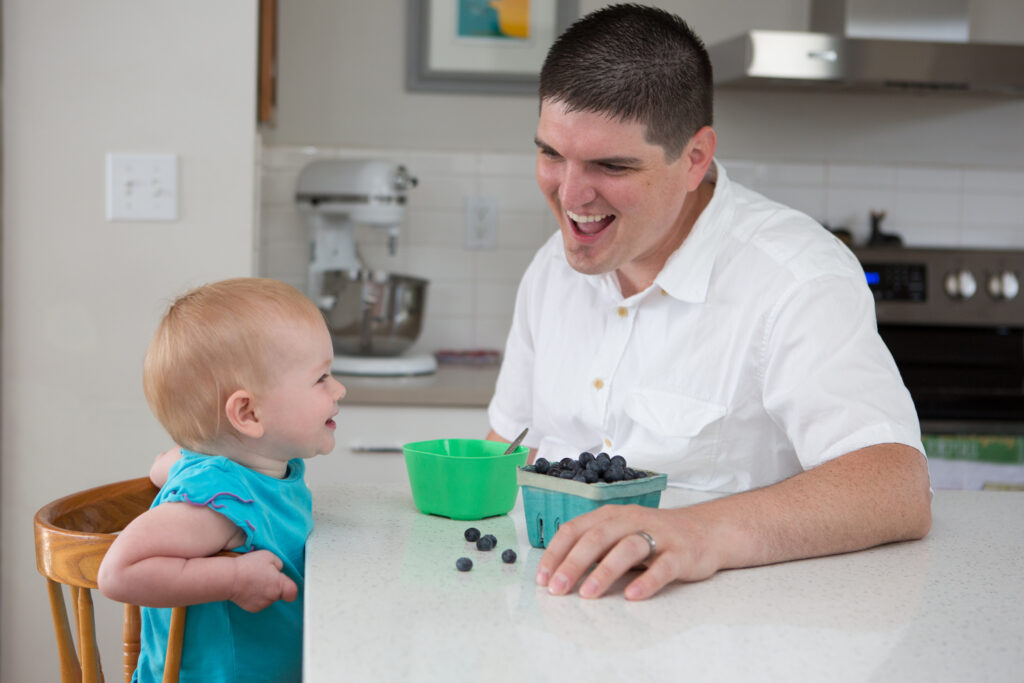
After experiencing a delay in starting their family, Francesca’s parents were absolutely thrilled when she was born.
“She is very fun,” says mom. “Francesca loves to laugh, dance to music, and is very social with other children.”
Her father’s favorite aspect of being a dad is holding Francesca and watching her process the world around her.
“I love that she always wants to do something with me, like reading books or playing outside,” says dad.
A family that eats together, stays together
During Francesca’s newborn visit, pediatrician Mary Ann Woodruff, MD shared about the importance of eating together as a family, and the impact it has on their daughter’s social development and nutrition.
Now, eating dinner together every night is a household routine that Francesca looks forward to.
“Combining her desire to eat and her father recently coming home from work, you have a spinning toddler, shouting, ‘Daddy come! Eat food! Eat food!'” says mom. “We love this kid.

Once everyone is settled in at the table, Francesca’s parents reach for her tiny hands to pray for dinner and say what they are thankful for.
Because mealtime serves as a prime time for open-ended conversation throughout family life, Pediatrics Northwest providers encourage parents to establish a mealtime routine during the infancy stage.
“Before parents know it, their toddler has grown up to be a busy teenager,” says Dr. Woodruff. “Mealtime is one of the very few times that family members reliably sit together to talk about their day and share stories.”
This becomes even more important as children get older. Studies show that children in families who enjoy meals together are more likely to choose strong pathways and avoid negative decisions.
“Compared to teens who have frequent family dinners (5 to 7 per week), those who have infrequent family dinners (fewer than 3 per week) are almost 4 times likelier to use tobacco; more than twice as likely to use alcohol; 2 ½ times likelier to use marijuana; and almost 4 times likelier to say they expect to try drugs in the future,” – The National Center on Addiction and Substance Abuse at Columbia University
“It’s about more than just food or eating,” says Dr. Woodruff. “It’s really about the powerful connecting time that happens around the table.”
Making family mealtime work for your family
Even with the benefits of eating together, Dr. Woodruff understands that conflicting work schedules and the needs of young children can make sitting down together tricky.
She shares three simple suggestions to the families in her care:
1. A party of two
Have whoever is able to gather at the table, gather! It can be just a party of two, and that is still beneficial to the child.
2. Breakfast or lunch
Nothings says it has to be dinner. It is really important for parents to sit down with their children, so if breakfast or lunch works better schedule-wise for both parents, do breakfast or lunch together.
3. Change up the location
The beautiful thing about mealtime is that it does not have to look a certain way. Try a picnic in the living room!

During the summer months, Francesca and her parents like to visit the farmers market. Her favorite part is seeing all the dogs and scoring a pint full of fresh blueberries!
Modeling healthy eating to overcome picky eaters
Mealtime is also a perfect opportunity for parents to model healthy eating, especially during the time periods when children become picky about texture or certain foods.
“Watching their parents or siblings eat healthy foods can help young children overcome pickiness,” says Dr. Woodruff.
By observing what her parents choose to eat, Francesca is learning how to develop healthy eating habits that will stay with her for a lifetime.
“I love that she asks for bananas, blueberries, hummus, sweet potatoes, and peas,” says mom.
“The frequency of shared family meals is significantly related to nutritional health in children and adolescents. Children and adolescents who share family meals three or more times per week are more likely to be in a normal weight range and have healthier dietary and eating patterns than those who share fewer than three family meals together,” (view study) – American Academy of Pediatrics.
Likewise, allowing children to be involved in meal planning will give them a vested interest in eating the meal. It also leads to developing a wider array of healthy eating habits.
It’s powerful when children can participate in meaningful and helpful ways around the table,” says Dr. Woodruff.
This can look like growing a part of a meal with your child, going to the grocery store or farmers market together, or allowing your child to set the dinner table before a meal.
Francesca and her mother take frequent trips to the grocery store together.
“Francesca likes to help hold fruits and vegetables as we shop. It gives us the opportunity to talk about the foods we are picking up,” says mom.
During the summer months, they like to visit the farmers market together. Francesca’s favorite part about the trip is seeing all the dogs and scoring a pint full of fresh blueberries.
“She absolutely loves blueberries!” says mom.

14-month-old Francesca is a sweet, easy going toddler with a happy temperament. One of her favorite actives is having family dance parties with plenty of music and singing!
Mealtime conversations help shape future ambitions
Family mealtime was very impactful for Dr. Woodruff as a child. The events and conversations held at the dinner table helped shape her desire to become a pediatrician.
“Because my dad was a physician, I was very fortunate to have their family friends in the medical field gather with us for dinner. I loved listening to the conversations and stories being told at the table,” recalls Dr. Woodruff.
At eight-years-old she remembers a specific family friend, who was also a pediatrician, having dinner with them frequently.
Dr. Woodruff found her captivating.
“Phyllis was so welcoming and open,” says Dr. Woodruff. “I said to myself, ‘I want to be just like her.'”
For Dr. Woodruff, it all went back to family mealtime. Her parents never compelled her to go into medical school, despite their backgrounds. They simply modeled it at the dinner table.

A medical home where everybody knows your name
One of the qualities Francesca’s parents appreciate most about Dr. Woodruff’s care is the intentional time she gives them at appointments.
“I feel like we’re never a burden and that it’s important to her that we are there,” says mom.
They also love how Pediatrics Northwest models their care around the idea of a medical home.
Medical Home – not a building, house, or hospital, but rather an approach to providing comprehensive primary care where everybody knows your name and your medical records are complete.
“The care is focused around us as a family and a couple,” says mom. “Dr. Woodruff not only cares about the medical component but she also cares about the whole aspect of raising a child.”
Dr. Woodruff enjoys watching how Francesca’s parents take delight in watching her learn about the world around her and being with her every step of the way.
“Her parents are just glowing about their daughter and being parents,” says Dr. Woodruff.
Related Stories


